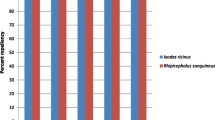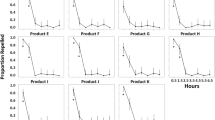Abstract
The present study had the aim to test the repellent potential of the compound icaridin = Saltidin® against the tick species Ixodes ricinus and Ixodes persulcatus using different formulations of the compound. Tests were done on backs of impregnated human hands, on impregnated linen cloth and versus impregnated dog hair. It was found that 1. Ixodes persulcatus—the common Eastern European, Russian Ixodes species is significantly sensitive to icaridin = Saltidin® as I. ricinus protecting for the test period of 5 h. This is an important finding, since I. persulcatus is the vector of agents of the severe Eastern meningoencephalitis; 2. that this repellent compound acts similarly on both I. ricinus and I. persulcatus, when sprayed either on naked skin or on cloths; 3. that there are only slight differences in duration of the repellency when using different formulations containing icaridin = Saltidin®; 4. that icaridin = Saltidin® sprayed on dog hair has identical repellent effects like those seen on human skin and cloths; thus, this compound can also be used to protect animals such as dogs, cats, horses; and 5. that the icaridin = Saltidin® did not induce a bad sensation on skin, nor bad smells; furthermore, it was not sticky and did not leave residuals neither on clothes nor on dog’s hair.
Similar content being viewed by others
References
Dautel H (2001) Ein Testsystem zur Detektion von Zeckenrepellentien. Entomologentagung Düsseldorf March 26-April 1.
Deplazes T, Eckert J, von Samson-Himmelstjerna G, Zahner H (2013) Textbook of parasitology of veterinary medicine, 3rd edn. Enke, Stuttgart
Kumar S, Prakash S, Kaushik MP, Rao KM (1992) Comparative activity of three repellents against the ticks Rhipicephalus sanguineus and Argas persicus. Med Vet Entomol 6:47–50
Löscher T, Burchard GD (2010) Tropical medicine in clinic and praxis, 4th edn. Thieme, Stuttgart
Marchio F (1996) Insect repellent 3535. A new alternative to DEET. SÖFW J 122:478–485
Mehlhorn H (2011) Nature helps. Parasitol Res Monographs Vol 1. Springer, New York
Mehlhorn H (2015) Encyclopedia of parasitology, 4th edn. Springer, New York
Mehlhorn H, Schmahl G, Schmidt J (2005) Extracts of the seeds of Vitex agnus castus proven to be highly efficacious as repellent against ticks, fleas, mosquitoes and biting flies. Parasitol Res 95:363–365
Mwangi EN, Hassanali A, Essuman S, Myandat E, Moreka L, Kimondo M (1995) Repellent and acaricidal properties of Ocimum suave against Rhipicephalus appendiculatus ticks. Exp Appl Acarol 19:11–18
Nentwig G (2003) Use of repellents as prophylactic agents. Parasitol Res 90:S40–S48
Perich MJ, Strickman D, Wirtz RA, Stockwell SA, Glick JI, Burge R, Hunt G, Lawyer PG (1995) Field evaluation of four repellents against Leptoconops americanus. J Med Entomol 32:306–309
Schreck CE, Fish D, McGovern TP (1995) Activity of repellents applied to skin for protection against Amblyomma americanum and Ixodes scapularis ticks (Acari: Ixodidae). J Am Mosqu Contr Assoc 11:136–140
Semmler M, Abdel-Ghaffar F, Al-Rasheid K, Mehlhorn H (2009) Nature helps: from research to products against bloodsucking arthropods. Parasitol Res 105:1483–1487
Semmler M, Abdel-Ghaffar F, Al-Rasheid KA, Mehlhorn H (2010) Comparison of the tick repellent efficacy of chemical and biological products originating from Europe and the USA. Parasitol Res 108:899–904
Solberg VB, Klein TA, McPherson KR, Bradford BA, Burge JR, Wirtz RA (1995) Field evaluation of DEET and piperidine repellent (A13-37220) against Amblyomma americanum (Acari: Ixodidae). J Med Entomol 32:870–875
Turberg A, Hansen O (2008) Acaricides and insecticides. In: Mehlhorn H (ed) Encyclopedia of parasitology, 4th edn. Springer, New York
Acknowledgments
The authors extend appreciations and to the Deanship of Scientific Research at King Saud University for funding the work through the international research group project IRG14-23.
Author information
Authors and Affiliations
Corresponding author
Rights and permissions
About this article
Cite this article
Abdel-Ghaffar, F., Al-Quraishy, S. & Mehlhorn, H. Length of tick repellency depends on formulation of the repellent compound (icaridin = Saltidin®): tests on Ixodes persulcatus and Ixodes ricinus placed on hands and clothes. Parasitol Res 114, 3041–3045 (2015). https://doi.org/10.1007/s00436-015-4506-z
Received:
Accepted:
Published:
Issue Date:
DOI: https://doi.org/10.1007/s00436-015-4506-z




